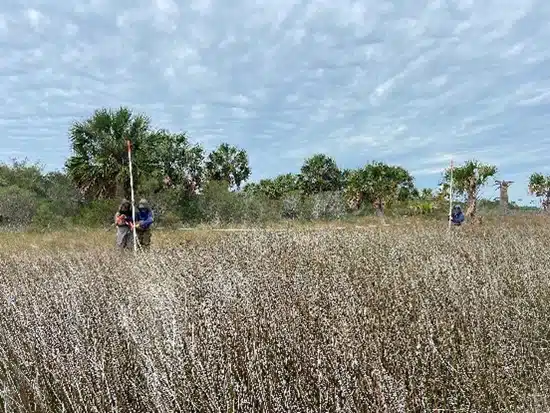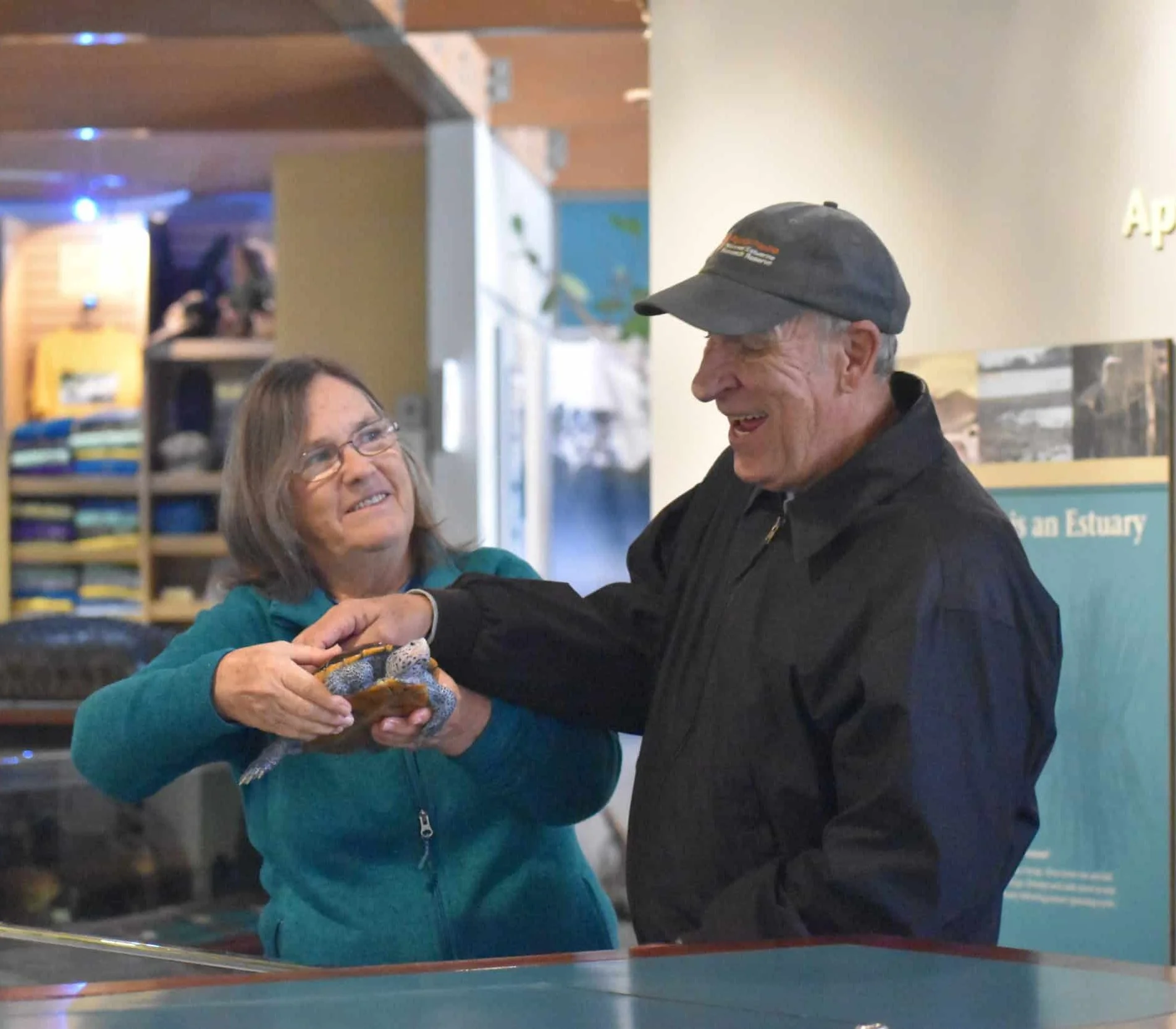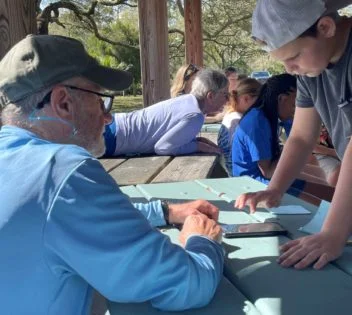OysterCatcher Spring 2024

Stewardship Staff Accomplish Spring Cleaning on Little St. George Island
Stewardship staff have been working hard to tidy up ANERR’s Little St. George Island managed areas. Staff have conducted maintenance on recreational hiking trails and campsites on the island, getting them ready to for spring visitors, including clearing vegetation, freshening trail markers, and checking signage. To learn more about recreational opportunities available at ANERR please visit https://www.apalachicolareserve.com/. Please remember to always Leave No Trace when visiting our natural areas! While on the island, staff also inventoried and cleaned sea turtle nesting signs in preparation for the upcoming summer nesting season that will start in May and end in October. All sea turtle activities are conducted by trained individuals permitted by FWC.


2024 Shorebird Nesting Season Begins
ANERR stewardship staff have also been visiting shorebird nesting areas to prepare them for nesting season, including checking site conditions and putting up signs to increase awareness. Many local areas host nesting shorebirds including Snowy Plovers, Wilson’s Plovers, American Oystercatchers, Least Terns, Black Skimmers, Brown Pelicans, and more. The sandy beaches of our barrier islands, sand spits on the baysides of these islands, Bird Island by the Apalachicola Bridge, Flagg Island south of St. Vincent, and the old St. George Island causeway area all important habitat where shorebirds nest and forage for food. Shorebird nesting season runs March through August or later, depending on the bird species. The old St. George Island Causeway is a designated Critical Wildlife Area which means it is completely off-limits to human visitors from March 1 – September 30. While some nesting areas may be marked by signs, others are not. Please visit our coastal areas with awareness. If you observe a bird conducting a broken wing display, acting aggravated, or find a nest, please leave the area immediately so bird parents can return and protect their young. Please keep dogs on a leash in beach areas so they do not chase parents off of or otherwise damage nests. ANERR works cooperatively with partners from the Florida Fish and Wildlife Conservation Commission, Audubon Florida, and volunteers to protect and monitor these sites for shorebirds and promote education and awareness. You can find more information about living with beach-nesting shorebirds here: https://myfwc.com/conservation/you-conserve/wildlife/shorebirds/.


Vegetation Transects Re-vamped for Spring Surveys

In preparation for our upcoming vegetation surveys, Research staff joined forces with Stewardship to install and maintain vegetation plot markers along a transect. Mangrove assessments are a recent addition to our annual surveys and the new plots needed to be demarcated. The Reserve’s vegetation monitoring program began in 2014 to document changes in macrophyte communities over time. As of 2021, surveys are conducted annually at three wetland sites.
In addition, all sites now have functional porewater wells. Old wells were removed, and a new set-up was installed to improve the long-term stability of these structures. Dataloggers are deployed within the wells to monitor marsh water quality, specifically water level, conductivity, and temperature.
Water Quality Towers Cleaned & Maintained
The Reserve’s water quality towers received a spring cleaning! Research staff were able to dive the four water quality towers in Apalachicola Bay to provide routine cleaning and maintenance. Roughly each quarter, staff remove biofouling that grows on the PVC tubes which house various monitoring equipment, most importantly the continuous water quality monitoring program’s dataloggers.
If this is not completed, the tubes can become a microenvironment that is no longer representative of the water surrounding it. As more algae, barnacles, oysters, and other organisms grow, they can block flow holes that allow water movement, affecting dissolved oxygen and other parameters. This removal is important as it allows for more accurate data collection from our instruments.

People of the Apalachicola: A Collaborative Project

Over the next year, a team of visiting researchers from the University of West Florida (UWF), Florida Public Archaeology Network, will be exploring human history in the Apalachicola National Estuarine Research Reserve. They hope to better understand how natural and cultural impacts can affect the long-term preservation of heritage sites and help the Reserve document and protect important cultural sites.
The project team includes Nicole Grinnan, M.A., RPA, Mike Thomin, M.A., Maritime Landscape Alliance for Preservation and Bria Brooks, a master’s student at UWF. Since January they have made three trips to survey sites in the watershed including Little St. Geroge Island, St. Vincent Island, Tate’s Hell State Forest, and other area sites. Dense swamps, rough seas, below-freezing temperatures, and rain did not deter the intrepid archaeologists as they visited sites to update records for existing sites and record new sites so that future development is aware of them. This will help local land managers prioritize efforts to preserve local cultural heritage sites.
A series of Community Conversations were held to understand what aspects of the past matter most to people living in the Apalachicola area today. Thanks to everyone who turned out and gave input to the project. If you are interested in learning more, go to fpan.us/projects/pota/
This work is sponsored by the National Estuarine Research Reserve System Science Collaborative, which supports collaborative research that addresses coastal management problems important to the reserves. The Science Collaborative is funded by the National Oceanic and Atmospheric Administration and managed by the University of Michigan Water Center.
Apalachicola NERR Hosts Annual Symposium
ANERR held their annual symposium at the end of February. This year, the focus was on restoration with the title, “Restoration Partnerships: From Bluffs to the Bay.” Over eighty participants attended across the Thursday and Friday sessions that delved into the habitat restoration work being accomplished by agencies and organizations throughout the Apalachicola Bay watershed, how partnerships greatly enhance the capacity for restoration successes, and funding opportunities for on-going and future restoration projects.
ANERR’s Lexy Preheim presented on restoration through invasive removal. The stewardship team at ANERR completed a case study on Triadica sebifera, Chinese tallow tree. The case study occurred in a 15-acre marsh surrounded by pine flatwoods around the ANERR nature center from 2014-2023. Spatial data, tree maturity, and treatment type were taken with each observation. The talk included a compilation of the project and ANERR’s invasive program. Diane Allix, Field Projects Coordinator with The Nature Conservancy, also gave information on the Cooperative Invasive Species Management Areas (CISMA) program to tie in the collaborative aspect.
Kim Miller, ANERR’s assistant manager, presented on the Estuary Restoration Teams (ERTs) across the state.
The final session of the symposium was facilitated by The Balmoral Group as part of the Apalachicola Regional Restoration Coordination Project, gathering lessons learned about collaboration, funding, and communication from all those in attendance regarding their experiences in past restoration projects.


Volunteer Appreciation!
Warm platitudes about the virtues of volunteers, while often true, do not even begin to explain the impact they have on the people and places where they work. At ANERR, these five volunteers bring an enormous treasure trove of knowledge and experience from their lives and paid work that benefits our visitors and employees alike.
Specifically, Kathy McKendree can be found in the nature center introducing people to our resident snake, educating them about the estuary and showing them the incredible warmth and kindness of the people who live here. She makes people from all over the world feel so welcome, not to mention smarter.
George Lorefice, affectionately known here as Lichen George prepares microscope samples from our living shoreline for more than a hundred fifth graders and then shows them the wonders of that invisible world in our outdoor classroom.
Like George, Dr. Maggie Helly volunteers to teach children of all ages on field trips and at the reserve. Though she identifies primarily as a learner, she was also a state recognized chemistry teacher and is highly experienced teaching teachers. She has joined us in classes with pre-K students all the way up to adults. She has taught with us on boats, on islands, on bluffs and even standing in the water. Her curiosity is infectious and inspiring. She is willing to help plan classes, execute them, analyze their merits afterwards and take out the trash. Maggie drives two hours to come to the reserve and says she gets paid in joy. What an extraordinary gift, Maggie and the other volunteers give to us!
Kathryn and Marcus Murray, our resident volunteers regale visitors with stories, run the Friends’ store, build anything from drone platforms to model boats children can sit in. Their presence allows estuary staff to devote time to conducting and improving classes and projects they might not otherwise be able to do. They are so attentive to small and giant tasks. Kathryn’s gentle presence (as sweet as the drawings in her nature journal) and persistent research when visitors have questions makes the nature center a lovely place for people to learn. On any given day, Marcus might be cleaning trash from the beach, writing poetry on his time sheet, cleaning the boardwalks or helping seine.
George Kalet would be diamond class on any airline, he donates so much time to our reserve. He has patrolled the beach early in the morning and late in the evening as a turtle volunteer, even rescuing disorientated baby turtles from a hotel pool one night. He has been a citizen scientist collecting and analyzing the presence of microplastics in our water. And, if this wasn’t enough, he runs the Friends of the Reserve store twice a week. For Kathy, Kathryn and George, this could mean ringing up purchases, giving fashion advice on our t-shirts, recommending books, talking about critters in an aquarium or in our watershed, suggesting good places to eat, discussing the oysters under the microscope, keeping a straight face when people ask strange questions (and they do), and taking children of all ages on a scavenger hunt. If you visit here and meet any of these men and women, your experience will be both magical and enlightening. And, somewhere else in the building, staff will be using their gift of time to us to work on better understanding, protecting and educating people about our watershed.





